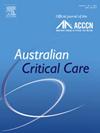跨专业认知辅助优化急性脊髓损伤患者拔管计划
IF 2.7
3区 医学
Q2 CRITICAL CARE MEDICINE
引用次数: 0
摘要
背景:急性脊髓损伤后重症监护病房患者的护理具有挑战性,特别是对于颈椎损伤和四肢瘫痪的患者,他们的肺炎和拔管失败率很高。主要目的是评估一种新的跨专业认知辅助工具的可用性,以优化急性四肢瘫痪患者的拔管计划。次要目标是(i)观察和比较临床医生在高保真模拟场景中的行为,(ii)比较临床医生在引入认知辅助之前和之后的自信自我评价。方法双方法设计。26名重症监护临床医生(医生、护士和物理治疗师)按随机顺序完成两个颈脊髓损伤患者模拟场景。在这两种场景之间,参与者被引导到新的认知辅助工具。模拟由盲法观察者使用标准化检查表进行视听记录和评分。模拟前后分别进行问卷调查和半结构化访谈。结果认知辅助在三个学科中均具有良好的可用性(系统可用性量表的平均得分为74.4)。引入认知辅助后,临床医生对完成独立呼吸评估有更高的信心(p <;0.01)和拔管所需的客观结果测量(p <;0.01),并与多学科团队讨论他们的客观发现和持续管理(p = 0.04)。肺炎相关因素显著增加(p <;0.001)和拔管准备情况(p <;0.01),并且完成第二次模拟所需的时间明显更多(p = 0.03)。模拟场景被描述为真实的,认知援助被积极地感知。结论跨专业认知辅助具有良好的可用性,增强了重症监护医师对急性颈脊髓损伤患者拔管准备情况的评估、信心和沟通。本文章由计算机程序翻译,如有差异,请以英文原文为准。
An interprofessional cognitive aid to optimise extubation planning for patients with acute spinal cord injury
Background
Early management of patients in the intensive care unit after acute spinal cord injury is challenging, particularly for patients with cervical injury and tetraplegia who have high rates of pneumonia and extubation failure.
Objectives
The primary objective was to evaluate the usability of a new interprofessional cognitive aid to optimise extubation planning for patients with acute tetraplegia. Secondary objectives were to (i) observe and compare clinician behaviour during high-fidelity simulation scenarios and (ii) compare clinician self-ratings of confidence before and after introduction to the cognitive aid.
Methods
Dual methods design. Twenty-six intensive care clinicians (doctors, nurses, and physiotherapists) completed two cervical spinal cord–injured patient simulation scenarios in a random order. Between their two scenarios, participants were orientated to the new cognitive aid. Simulations were audiovisually recorded and scored by a blinded observer using a standardised checklist. Pre and post simulation questionnaires and semistructured interviews were completed.
Results
The cognitive aid had good usability across all three disciplines (mean score on the System Usability Scale was 74.4). After introduction to the cognitive aid, clinicians had higher confidence with completing an independent respiratory assessment (p < 0.01) and objective outcome measures required for extubation (p < 0.01) and to discuss their objective findings and ongoing management with the multidisciplinary team (p = 0.04). Significantly more factors related to pneumonia (p < 0.001) and extubation readiness (p < 0.01) were identified, and significantly more time was taken to complete the second simulation (p = 0.03). The simulation scenarios were described as realistic, and the cognitive aid was positively perceived.
Conclusions
The interprofessional cognitive aid had good usability and enhanced intensive care clinicians’ assessment, confidence, and communication about the extubation readiness of patients with acute cervical spinal cord injury.
求助全文
通过发布文献求助,成功后即可免费获取论文全文。
去求助
来源期刊

Australian Critical Care
NURSING-NURSING
CiteScore
4.90
自引率
9.10%
发文量
148
审稿时长
>12 weeks
期刊介绍:
Australian Critical Care is the official journal of the Australian College of Critical Care Nurses (ACCCN). It is a bi-monthly peer-reviewed journal, providing clinically relevant research, reviews and articles of interest to the critical care community. Australian Critical Care publishes peer-reviewed scholarly papers that report research findings, research-based reviews, discussion papers and commentaries which are of interest to an international readership of critical care practitioners, educators, administrators and researchers. Interprofessional articles are welcomed.
 求助内容:
求助内容: 应助结果提醒方式:
应助结果提醒方式:


